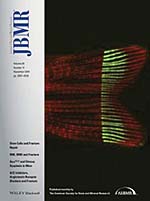Recidoro AM, Roof AC, Schmitt M, Worton LE, Petrie T, Strand N, Ausk BJ, Srinivasan S, Moon RT, Gardiner EM, Kaminsky W, Bain SD, Allan CH, Gross TS, Kwon RY.
J Bone Miner Res. 2014 May 7. doi: 10.1002/jbmr.2274. [Epub ahead of print]
 In a recent article in the Journal of Bone and Mineral Research, researchers from the Orthopaedics Research Lab developed a model of Botulinum toxin (BTx)-induced muscle paralysis in adult zebrafish and examined its effects on intramembranous ossification during tail fin regeneration.
In a recent article in the Journal of Bone and Mineral Research, researchers from the Orthopaedics Research Lab developed a model of Botulinum toxin (BTx)-induced muscle paralysis in adult zebrafish and examined its effects on intramembranous ossification during tail fin regeneration.
Intramuscular administration of BTx has been associated with impaired osteogenesis in diverse conditions of bone formation (e.g., development, growth, and healing), yet the mechanisms of neuromuscular-bone crosstalk underlying these deficits have yet to be identified. Motivated by the emerging utility of zebrafish (Danio rerio) as a rapid, genetically tractable, and optically transparent model for human pathologies (as well as the potential to interrogate neuromuscular-mediated bone disorders in a simple model that bridges in vitro and more complex in vivo model systems), in this study we developed a model of BTx-induced muscle paralysis in adult zebrafish, and examined its effects on intramembranous ossification during tail fin regeneration. BTx administration induced rapid muscle paralysis in adult zebrafish in a manner that was dose-dependent, transient, and focal, mirroring the paralytic phenotype observed in animal and human studies. During fin regeneration, BTx impaired continued bone ray outgrowth, morphology, and patterning, indicating defects in early osteogenesis. Further, BTx significantly decreased mineralizing activity and crystalline mineral accumulation, suggesting delayed late-stage osteoblast differentiation and/or altered secondary bone apposition. Bone ray transection proximal to the amputation site focally inhibited bone outgrowth in the affected ray, implicating intra- and/or inter-ray nerves in this process. Taken together, these studies demonstrate the potential to interrogate pathological features of BTx-induced osteoanabolic dysfunction in the regenerating zebrafish fin, define the technological toolbox for detecting bone growth and mineralization deficits in this process, and suggest that pathways mediating neuromuscular regulation of osteogenesis may be conserved beyond established mammalian models of bone anabolic disorders.